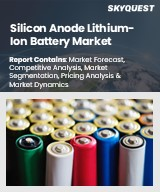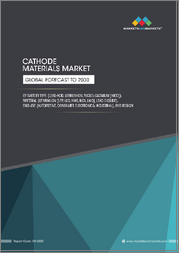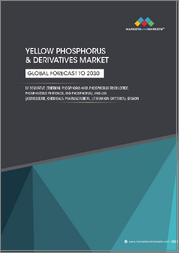
|
시장보고서
상품코드
1721445
수산화리튬 시장 기회, 성장 촉진요인, 산업 동향 분석 및 예측(2025-2034년)Lithium Hydroxide Market Opportunity, Growth Drivers, Industry Trend Analysis, and Forecast 2025 - 2034 |
||||||
세계의 수산화리튬 시장은 2024년 252억 달러로 평가되었고, CAGR 15.4%를 나타내 2034년에는 1,051억 달러에 이를 것으로 추정되고 있습니다. 생산에 필수적인 부품으로서, 강한 지지를 모으고 있습니다. 이 전지는 기존의 대체품에 비해 뛰어난 에너지 밀도, 긴 수명, 열 안정성을 실현하고 있습니다.

그 결과, 수산화리튬은 탄산리튬을 대신하여 여러 용도로 급속히 사용되게 되고 있습니다. 생산과 현지화 공급망을 지원하는 노력이 시장 확대를 더욱 가속화하고 있습니다.
| 시장 범위 | |
|---|---|
| 시작 연도 | 2024년 |
| 예측 연도 | 2025-2034년 |
| 시작 금액 | 252억 달러 |
| 예측 금액 | 1,051억 달러 |
| CAGR | 15.4% |
시장은 주로 무수물과 모노하이드레이트의 두 가지 형태로 구분되며, 모노하이드레이트 부문이 최대의 점유율을 차지하고, 2024년 시장 규모는 157억 달러였습니다. 리튬 이온 전지의 정극 재료의 합성에 적합하기 때문입니다. 전기자동차와 에너지 저장 시스템이 세계 시장에서 계속 확대되고 있기 때문에 수산화 리튬 모노하이드레이트 수요는 예측 기간을 통해 꾸준히 성장할 것으로 예측됩니다.
배터리 용도 분야는 수산화리튬 시장을 선도하고, 2024년에는 154억 달러의 수익을 올렸고, 2025년부터 2034년에 걸쳐 16.4%의 연평균 복합 성장률(CAGR)을 나타낼 것으로 예측되고 있습니다. 이 건전지는 전기자동차나 대규모 에너지 저장 시스템에서 널리 사용되고 있으며, 환경 문제에 대한 관심의 높아짐과 그린 기술에의 정책 지원에 의해 어느 쪽도 전례없는 성장을 이루고 있습니다.
미국의 수산화리튬 시장만으로도, 2024년에는 54억 달러로 평가되었고, EV 인프라, 기가팩토리 개척, 클린 에너지 구상에의 다액의 투자가 그 원동력이 되었습니다. 미국은 리튬 이온 전지공급 체인에 있어서의 강국으로서 대두하고 있어, 고품질의 수산화 리튬에 대한 수요가 빠르게 증가하고 있습니다.
시장 주요 기업은 Merck, MP Biomedicals, Nanografi, Thermo Fisher Scientific, Glentham Life Sciences, Vishnupriya Chemicals, Loba Chemie, Sisco Research Laboratories, American Elements, Stanford Advanced Materials 등이 있습니다. 이러한 기업은 생산 능력 확대, 장기 조달 계약 확보, EV 및 재생 가능 에너지 기업과의 파트너십 강화에 주력하고 있습니다.
목차
제1장 조사 방법과 범위
제2장 주요 요약
제3장 업계 인사이트
- 생태계 분석
- 밸류체인에 영향을 주는 요인
- 이익률 분석
- 파괴적 혁신
- 향후 전망
- 제조업체
- 유통업체
- 공급업체의 상황
- 이익률 분석
- 주요 뉴스와 대처
- 규제 상황
- 영향요인
- 성장 촉진요인
- 전기자동차(EV) 수요 증가
- 전지 화학에 있어서의 기술 진보
- 정부 인센티브와 정책
- 업계의 잠재적 위험 및 과제
- 공급망의 혼란
- 환경과 규제상의 과제
- 성장 촉진요인
- 성장 가능성 분석
- Porter's Five Forces 분석
- PESTEL 분석
제4장 경쟁 구도
- 서론
- 기업 시장 점유율 분석
- 경쟁 포지셔닝 매트릭스
- 전략적 전망 매트릭스
제5장 시장 추계·예측 : 순도별(2021-2034년)
- 주요 동향
- 55%
- 99%
- 99.30%
- 기타
제6장 시장 추계·예측 : 형태별(2021-2034년)
- 주요 동향
- 무수
- 모노하이드레이트
제7장 시장 추계·예측 : 용도별(2021-2034년)
- 주요 동향
- 배터리
- 리튬 이온 배터리
- 에너지 저장 시스템(ESS)
- 그리스 및 윤활제
- 유리 및 세라믹
- 에어컨 및 가습 시스템
- 화학 합성
- 이산화탄소 흡수
- 기타
제8장 시장 추계·예측 : 최종 용도별(2021-2034년)
- 주요 동향
- 자동차
- 전기자동차(EV)
- 하이브리드 전기자동차(HEV)
- 일렉트로닉스 및 에너지 저장
- 산업 제조
- 항공우주
- 화학
- 기타
제9장 시장 추계·예측 : 지역별(2021-2034년)
- 주요 동향
- 북미
- 미국
- 캐나다
- 유럽
- 독일
- 영국
- 프랑스
- 스페인
- 이탈리아
- 네덜란드
- 아시아태평양
- 중국
- 인도
- 일본
- 호주
- 한국
- 라틴아메리카
- 브라질
- 멕시코
- 아르헨티나
- 중동 및 아프리카
- 사우디아라비아
- 남아프리카
- 아랍에미리트(UAE)
제10장 기업 프로파일
- American Elements
- Glentham Life Sciences
- Loba Chemie
- Merck
- MP Biomedicals
- Nanografi
- Sisco Research Laboratories
- Stanford Advanced Materials
- Thermo Fisher Scientific
- Vishnupriya Chemicals
The Global Lithium Hydroxide Market was valued at USD 25.2 billion in 2024 and is estimated to grow at a CAGR of 15.4% to reach USD 105.1 billion by 2034. This upward trajectory is primarily driven by the explosive rise in electric vehicle (EV) adoption and the growing emphasis on renewable energy integration worldwide. Lithium hydroxide is gaining strong traction as a vital component in the production of high-performance lithium-ion batteries, particularly those with high nickel content. These batteries deliver superior energy density, extended lifespan, and enhanced thermal stability compared to traditional alternatives. With nations pushing for decarbonization and clean mobility, the demand for energy-dense, long-lasting battery technologies continues to skyrocket.

As a result, lithium hydroxide is quickly replacing lithium carbonate in several applications, as its performance benefits cater precisely to the evolving requirements of modern battery systems. The increasing emphasis on energy storage systems, both for grid stability and residential backup, is also contributing to the growth of the lithium hydroxide market. Rapid technological advancements and government-led initiatives to support battery production and localized supply chains further accelerate the market expansion. The material's relevance is only expected to intensify as OEMs, battery producers, and policymakers align toward a net-zero future, making lithium hydroxide a strategic asset in global energy transformation.
| Market Scope | |
|---|---|
| Start Year | 2024 |
| Forecast Year | 2025-2034 |
| Start Value | $25.2 Billion |
| Forecast Value | $105.1 Billion |
| CAGR | 15.4% |
The market is segmented primarily into two forms-anhydrous and monohydrate-with the monohydrate segment commanding the largest share, valued at USD 15.7 billion in 2024. Manufacturers prefer the monohydrate form due to its cost-effectiveness, easier handling properties, and compatibility with the synthesis of cathode materials in lithium-ion batteries. As electric vehicles and energy storage systems continue to expand across global markets, the demand for lithium hydroxide monohydrate is projected to grow steadily through the forecast period.
The battery application segment led the lithium hydroxide market, generating USD 15.4 billion in revenue in 2024, and is anticipated to grow at a CAGR of 16.4% from 2025 to 2034. The surge in demand is primarily due to the need for high-purity lithium hydroxide, a critical component in the formulation of high-nickel cathodes for lithium-ion batteries. These batteries are widely used in electric vehicles and large-scale energy storage systems, both of which are experiencing unprecedented growth due to rising environmental concerns and policy support for green technologies.
The U.S. Lithium Hydroxide Market alone reached USD 5.4 billion in 2024, fueled by heavy investments in EV infrastructure, gigafactory development, and clean energy initiatives. With the U.S. emerging as a powerhouse in the lithium-ion battery supply chain, the demand for high-quality lithium hydroxide is scaling up rapidly.
Leading companies in the global market include Merck, MP Biomedicals, Nanografi, Thermo Fisher Scientific, Glentham Life Sciences, Vishnupriya Chemicals, Loba Chemie, Sisco Research Laboratories, American Elements, and Stanford Advanced Materials. These players are focused on expanding production capacities, securing long-term sourcing contracts, and strengthening partnerships with EV and renewable energy firms. Research and development investments aimed at improving product purity and efficiency remain a strategic priority.
Table of Contents
Chapter 1 Methodology and Scope
- 1.1 Market scope and definition
- 1.2 Base estimates and calculations
- 1.3 Forecast calculation
- 1.4 Data sources
- 1.4.1 Primary
- 1.4.2 Secondary
- 1.4.2.1 Paid sources
- 1.4.2.2 Public sources
- 1.5 Primary research and validation
- 1.5.1 Primary sources
- 1.5.2 Data mining sources
Chapter 2 Executive Summary
- 2.1 Industry synopsis, 2021-2034
Chapter 3 Industry Insights
- 3.1 Industry ecosystem analysis
- 3.1.1 Factor affecting the value chain
- 3.1.2 Profit margin analysis
- 3.1.3 Disruptions
- 3.1.4 Future outlook
- 3.1.5 Manufacturers
- 3.1.6 Distributors
- 3.2 Supplier landscape
- 3.3 Profit margin analysis
- 3.4 Key news and initiatives
- 3.5 Regulatory landscape
- 3.6 Impact forces
- 3.6.1 Growth drivers
- 3.6.1.1 Rising demand for electric vehicles (EVs)
- 3.6.1.2 Technological advancements in battery chemistry
- 3.6.1.3 Government incentives and policies
- 3.6.2 Industry pitfalls and challenges
- 3.6.2.1 Supply chain disruptions
- 3.6.2.2 Environmental and regulatory challenges
- 3.6.1 Growth drivers
- 3.7 Growth potential analysis
- 3.8 Porter’s analysis
- 3.9 PESTEL analysis
Chapter 4 Competitive Landscape, 2024
- 4.1 Introduction
- 4.2 Company market share analysis
- 4.3 Competitive positioning matrix
- 4.4 Strategic outlook matrix
Chapter 5 Market Estimates and Forecast, By Purity, 2021 – 2034 (USD Billion) (Kilo Tons)
- 5.1 Key trends
- 5.2 55%
- 5.3 99%
- 5.4 99.30%
- 5.5 Others
Chapter 6 Market Estimates and Forecast, By Form, 2021 – 2034 (USD Billion) (Kilo Tons)
- 6.1 Key trends
- 6.2 Anhydrous
- 6.3 Monohydrate
Chapter 7 Market Estimates and Forecast, By Application, 2021 – 2034 (USD Billion) (Kilo Tons)
- 7.1 Key trends
- 7.2 Batteries
- 7.2.1 Lithium-ion batteries
- 7.2.2 energy storage systems (ESS)
- 7.3 Greases and lubricants
- 7.4 Glass and ceramics
- 7.5 Air conditioning and humidification systems
- 7.6 Chemical synthesis
- 7.7 Carbon dioxide absorption
- 7.8 Others
Chapter 8 Market Estimates and Forecast, By End Use, 2021 – 2034 (USD Billion) (Kilo Tons)
- 8.1 Key trends
- 8.2 Automotive
- 8.2.1 Electric vehicles (EVs)
- 8.2.2 Hybrid electric vehicles (HEVs)
- 8.3 Electronics and energy storage
- 8.4 Industrial manufacturing
- 8.5 Aerospace
- 8.6 Chemical
- 8.7 Others
Chapter 9 Market Estimates and Forecast, By Region, 2021 – 2034 (USD Billion) (Kilo Tons)
- 9.1 Key trends
- 9.2 North America
- 9.2.1 U.S.
- 9.2.2 Canada
- 9.3 Europe
- 9.3.1 Germany
- 9.3.2 UK
- 9.3.3 France
- 9.3.4 Spain
- 9.3.5 Italy
- 9.3.6 Netherlands
- 9.4 Asia Pacific
- 9.4.1 China
- 9.4.2 India
- 9.4.3 Japan
- 9.4.4 Australia
- 9.4.5 South Korea
- 9.5 Latin America
- 9.5.1 Brazil
- 9.5.2 Mexico
- 9.5.3 Argentina
- 9.6 Middle East and Africa
- 9.6.1 Saudi Arabia
- 9.6.2 South Africa
- 9.6.3 UAE
Chapter 10 Company Profiles
- 10.1 American Elements
- 10.2 Glentham Life Sciences
- 10.3 Loba Chemie
- 10.4 Merck
- 10.5 MP Biomedicals
- 10.6 Nanografi
- 10.7 Sisco Research Laboratories
- 10.8 Stanford Advanced Materials
- 10.9 Thermo Fisher Scientific
- 10.10 Vishnupriya Chemicals



















